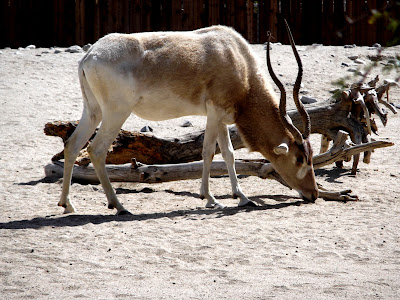1. The African bongo, a type of antelope, has a prehensile tongue that it uses to grab vegetation, much like a giraffe.
 |
| A picture of an addax that I took while in Palm Desert, California, at the excellent zoo called "The Living Desert" |
3. The addax also is very lightly colored, which helps to reflect heat away from the animal, keeping it cool.
4. The South American rhea can run up to 40 m.p.h.
 |
| A picture of the rhea that my mother took at the Natural Bridge Wildlife Ranch on our visit in 2008. The rhea is one of the ratites, like the ostrich and the emu, amongst others. |
6. The Watusi is the largest horned animal in the world, and its horns can be six feet across when fully grown.
 |
| A picture of a Watusi, with a calf, that my mother took when we visited the Natural Bridge Wildlife Ranch in 2008 |
 |
| A small group of springbok at the Natural Bridge Wildlife Ranch in 2011 |
9. The gemsbok was kept in large, semi-domesticated numbers in ancient Egypt, where they were killed for sacrificial purposes.
10. The Indian barasingha "has the unique ability to submerge their heads in water while closing their nasal passages," which "allows them to take advantage of vegetation in the swampy areas of their homeland."
11. The name "wildebeest" came from the Dutch settlers who settles in South Africa. It means (can you guess?) "wild beast."
12. The nilgai, or the bluebull, is the largest of the Asian antelope.
13. The "Near Threatened" white rhinoceros is the largest of all of the rhinoceros species, and the second largest land mammal, second only to the African elephant.
14. The white rhino will wallow in mud to cool off, as well as to help protect their skin.
15. The name "rhinoceros" comes from the Greek words "rhino" (which means nose) and "ceros" (which means horn). Think about the name Triceratops real fast: tri=three, tops=face, so then cera (like "ceros") = horn!
16. The "Critically Endangered" bactrian camel, the larger of the two camel species, can go several days without no water, spit when agitated, and can survive extreme temperature swings, from -20 degrees F, all of the way to 100 degrees F!
 |
| A picture of the bactrian camel that I took at the Denver Zoo when I went there with my friends Masaki Kleinkopf and Brynn Conroy in April of 2012 |
 |
| This picture of ostriches stalking our car looks like something out of Jurassic Park |
 |
| An ostrich accosting my sister for food at the Natural Bridge Wildlife Ranch in 2011 |
19. The gait of the giraffe is unique amongst quadrupeds. As they walk, they swing both of their feet on one side of their body at the same time.
 |
| A picture of one of the giraffes from the Cheyenne Mountain Zoo from my visit a few weeks ago |
21. The heart of the giraffe can pump up to 20 gallons of blood per minute.
22. There are two sub-species of sika (type of deer). The Formosan sika, which inhabits Siberia, and the Japanese sika, native to Japan and Korea.
 |
| A picture of a Japanese sika that I took in 2011 at the Natural Bridge Wildlife Ranch |
 |
| A picture of a small herd of elk that my mother took in 2006 at Yellowstone National Park |







Hi Zack,
ReplyDeleteMy name is Jane and I'm with Dwellable.
I was looking for blog posts about things to do in Palm Desert to share on our site and I came across your post...If you're open to it, shoot me an email at jane(at)dwellable(dot)com.
Hope to hear from you :)
Jane